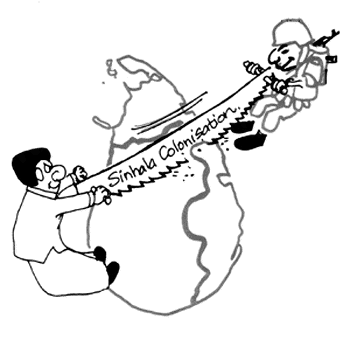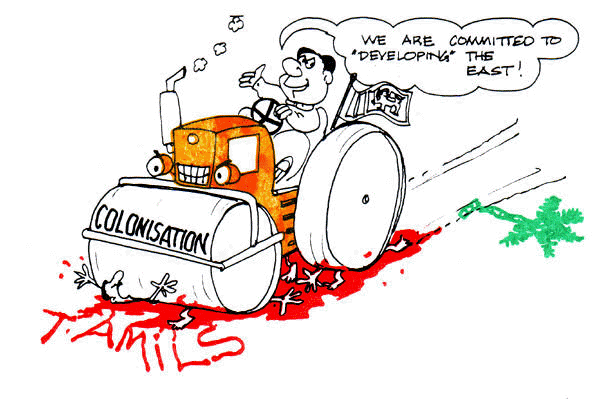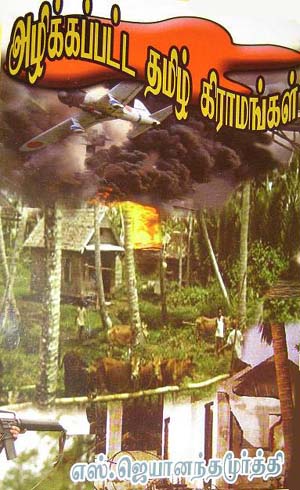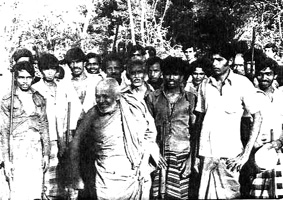|
  INDICTMENT AGAINST SRI LANKA INDICTMENT AGAINST SRI LANKA
The Charge is Ethnic Cleansing
SINHALA COLONISATION OF
TAMIL HOMELAND

 On the Traditional Tamil Homeland: The Facts -
Sachi Sri Kantha
On the Traditional Tamil Homeland: The Facts -
Sachi Sri Kantha
 Walter Schwarz, Minority Rights Group on Colonisation
in Eastern Province, 1979
Walter Schwarz, Minority Rights Group on Colonisation
in Eastern Province, 1979
 Virginia Leary, International Commission of Jurists,
(ICJ) on State Colonisation of Traditional Tamil Areas,
June 1981
Virginia Leary, International Commission of Jurists,
(ICJ) on State Colonisation of Traditional Tamil Areas,
June 1981
 On
forced eviction of Tamils - Robert Kilroy-Silk,
M.P. and Roger Sims, M.P United Kingdom Parliamentary
Human Rights Group Report, February 1985 On
forced eviction of Tamils - Robert Kilroy-Silk,
M.P. and Roger Sims, M.P United Kingdom Parliamentary
Human Rights Group Report, February 1985
"Witnesses also
confirmed allegations
made to us that whole villages have been emptied and
neighbourhoods have been driven by the army from
their homes and occupations and turned into refugees
dependent on the government for dry
rations..."
 Joint Memorandum submitted by a group of nine Non
Governmental Organisations, February 1985
Joint Memorandum submitted by a group of nine Non
Governmental Organisations, February 1985
"Sri
Lanka has announced plan
to colonise all Tamil areas with Sinhala settlers to
reflect the nationwide population ratio of 75%
Sinhalese and 25% other minority ethnic
groups."
 Sinhala
Mahaveli Ministry Official, Herman Gunaratne in the Sri
Lanka Sunday Times, 26 August 1990 Sinhala
Mahaveli Ministry Official, Herman Gunaratne in the Sri
Lanka Sunday Times, 26 August 1990
"All wars
are fought for land.. By
settling the (Sinhala) people in the Maduru Oya we
were seeking to have in the Batticaloa zone a mass of
persons opposed to a separate state."
 Open Letter from the
Central Committee of the Liberation Tigers of Tamil
Eelam, to the Sinhala people, 22 September 1991 Open Letter from the
Central Committee of the Liberation Tigers of Tamil
Eelam, to the Sinhala people, 22 September 1991
"The Sinhala people should know
that the so called state aided 'colonisation schemes'
within Tamil areas having nothing to do with solving
landlessness among the Sinhala poor"
 Government Policies Threaten Economic Future and
Ancestral Homeland of Tamils - Professor
Chelvadurai Manogaran, July 1996
Government Policies Threaten Economic Future and
Ancestral Homeland of Tamils - Professor
Chelvadurai Manogaran, July 1996
 Professor Chelvadurai Manogaran
June 1997 Professor Chelvadurai Manogaran
June 1997
 Sinhala Colonisation in the
Hereditary Tamil Regions of the Island of Sri Lanka -
K.Satchithanandan, March 2000 Sinhala Colonisation in the
Hereditary Tamil Regions of the Island of Sri Lanka -
K.Satchithanandan, March 2000
 Buddha's Statues - Symbol of Sinhalese
Hegemony, - A.Thangavelu, May 2005 Buddha's Statues - Symbol of Sinhalese
Hegemony, - A.Thangavelu, May 2005
 Sinhala Colonisation of East Tamil Eelam
- Arujna, Oru Paper Editorial, May 2007 Sinhala Colonisation of East Tamil Eelam
- Arujna, Oru Paper Editorial, May 2007
 Presentation on
Post Resettlement Development Plan for The Eastern
Region by M.S.Jayasinghe Advisor Sri Lanka Ministry
of Nation Building and Estate Infrastructure
Development Presentation on
Post Resettlement Development Plan for The Eastern
Region by M.S.Jayasinghe Advisor Sri Lanka Ministry
of Nation Building and Estate Infrastructure
Development
 President
Rajapakse's Colonisation of East Tamil Eelam, 2007
- President
Rajapakse's Colonisation of East Tamil Eelam, 2007
-
"...whilst the
current landscape in the East is one of humanitarian
crisis and endemic human rights abuses, the current
focus on human rights issues, which whilst performing
the essential task of exposing the authoritarianism
and violence of the current regime, is insufficient
to capture the cold calculations and reasoning in the
intentions of the Sri Lankan State which has once
again returned to the the logic of Sinhala
colonisation.." David Rampton, Lecturer, SOAS, University of
London

 Destroyed
Tamil Villages in East - S.Jeyananthamoorthy,
2008 Destroyed
Tamil Villages in East - S.Jeyananthamoorthy,
2008
 "The detailed facts about
the horrendous events that took place in 24 Villages
from the two districts are documented in this book.
The villages in Batticaloa district include
Mayilanthanai, Meeraavoadai, Ki'n'niyadi,
Puluddumaanodai, Thaanthaamalai, Sinnavaththai,
Vaakarai, Thoa'nithaaddamadu, Thiyaavaddavaan,
Oamadiyaamadu, Ka'n'napuram 35th colony,
Valaiyi'ravu, Ea'raavoor, Saththurukko'ndaan,
Ve'l'laamaichcheanai, Pullumalai, Vadamunai,
Kokkaddichoalai, Makizhadiththeevu, and other
villages including Veeramunai,
Thangkavealaayuthapuram, Karavaahu, Thiraaykkea'ni,
Udumpanku'lam in Ampaa'rai district." more "The detailed facts about
the horrendous events that took place in 24 Villages
from the two districts are documented in this book.
The villages in Batticaloa district include
Mayilanthanai, Meeraavoadai, Ki'n'niyadi,
Puluddumaanodai, Thaanthaamalai, Sinnavaththai,
Vaakarai, Thoa'nithaaddamadu, Thiyaavaddavaan,
Oamadiyaamadu, Ka'n'napuram 35th colony,
Valaiyi'ravu, Ea'raavoor, Saththurukko'ndaan,
Ve'l'laamaichcheanai, Pullumalai, Vadamunai,
Kokkaddichoalai, Makizhadiththeevu, and other
villages including Veeramunai,
Thangkavealaayuthapuram, Karavaahu, Thiraaykkea'ni,
Udumpanku'lam in Ampaa'rai district." more
 Walter Schwarz: Minority Rights Group Report on Tamils of
Sri Lanka, 1979
Walter Schwarz: Minority Rights Group Report on Tamils of
Sri Lanka, 1979
"In 1978, Tamil spokesmen complained that the
momentum of colonisation was greater than ever.
They referred in particular to the Mahaveli Diversion
project, supported by the World Bank, in the Eastern
Province, under which Sinhalese families were being
brought in from the South. They pointed out that the
Maduruoya Scheme in the Eastern Province, backed by
Canadian assistance, was having the same effect."
 Virginia Leary on State Colonisation of Traditional Tamil
Areas - Ethnic Conflict and Violence in Sri
Lanka - Report of a Mission to Sri Lanka on behalf of the
International Commission of Jurists, July/August
1981
Virginia Leary on State Colonisation of Traditional Tamil
Areas - Ethnic Conflict and Violence in Sri
Lanka - Report of a Mission to Sri Lanka on behalf of the
International Commission of Jurists, July/August
1981
"...Tamils have objected to State colonisation schemes
which import large numbers of Sinhalese into traditional
Tamil areas. The Tamil concern about colonisation is
related to insecurity about their physical safety and to
fears that Tamils will become a minority in their
traditional homelands. The government maintains that
since Sri Lanka is a single country citizens may freely
move into any part of the country and that it is
necessary to transplant some populations to more
productive areas. The Tamils answer that they are not
opposed to individual migration but only to large scale
government colonisation schemes which change the ethnic
composition of an area...
The government should give renewed attention to Tamil
concern over government sponsored colonisation schemes
which bring large numbers of Sinhalese into Tamil areas
and thus change the ethnic composition in such areas.
This is particularly important in view of the insecurity
of Tamils due to communal violence against them in areas
where they live as a minority..."
 On forced eviction of
Tamils - Robert Kilroy-Silk, M.P. and Roger Sims,
M.P United Kingdom Parliamentary Human Rights Group
Report on February 1985 On forced eviction of
Tamils - Robert Kilroy-Silk, M.P. and Roger Sims,
M.P United Kingdom Parliamentary Human Rights Group
Report on February 1985
"Witnesses
also confirmed allegations made to us that whole
villages have been emptied and neighbourhoods have been
driven by the army from their homes and occupations and
turned into refugees dependent on the government for dry
rations... The human rights transgressed in such a course
of action do not need to be detailed here...
More important is that rightly or wrongly it tends to
lend credibility to the view so frequently put to us that
it is the Government's objective either to drive the
Tamils out of the north and east in sufficient numbers so
as to reduce their majority in the north and in the east,
a process that would be aided by the Government's
announced policy of settling armed Sinhalese people in
former Tamil areas... or to drive the Tamils out
altogether.
We cannot make a judgement on this issue. We can say,
without doubt, that the Government is driving Tamils from
their homes and does intend to settle Sinhalese people in
these areas. This, at least, lends support to the more
extreme version believed by most Tamils."
 Professor Chelvadurai Manogaran
June 1997 [full
text] Professor Chelvadurai Manogaran
June 1997 [full
text]
 "Sri Lanka has announced plan to colonise all Tamil areas
with Sinhala settlers to reflect the nationwide
population ratio of 75% Sinhalese and 25% other minority
ethnic groups." Joint Memorandum submitted by a
group of nine Non Governmental Organisations, February
1985 [see full text]
"Sri Lanka has announced plan to colonise all Tamil areas
with Sinhala settlers to reflect the nationwide
population ratio of 75% Sinhalese and 25% other minority
ethnic groups." Joint Memorandum submitted by a
group of nine Non Governmental Organisations, February
1985 [see full text]
consisting of the Anti-Slavery
Society for the Protection of Human Rights, Centre
Europe - Tiers Monde, Disabled Peoples International,
International Federation of Human Rights, International
League for the Rights and Liberation of People, Pax
Christi International, Pax Romana - International
Catholic Movement for Intellectual and Cultural
Affairs, International Movement of Catholic Students,
International Movement of Catholic Students,
International Movement for Fraternal Union among Races
and People, and World Student Christian Federation at
the UN Commission on Human Rights in February
1985
"The President of Sri Lanka has
announced his Government's plan to colonise all Tamil
areas with Sinhala settlers to reflect the nationwide
population ratio of 75% Sinhalese and 25% other minority
ethnic groups. This is calculated to undermine the
numerical strength of Tamils in areas where they have
traditionally lived.
The Minister of National Security told conference of
District Ministers on January 8, 1985 that the only way
to root out terrorism was to remove the concept of
'traditional homelands' and create parity between
different communities. He announced that according to the
plan 30,000 Sinhalese families will be settled in the
Tamil north this year.
Under the plan 250 families would be selected from each
of the Sinhala constituencies for resettlement in the
northern province. Such settlements would be created this
year in Killinochchi, Vavuniya, Mullaitivu and Mannar
districts and extended to the Jaffna Peninsula next
year.
The new settlers would be given military training and
equipment to safeguard themselves. In fact, in
certain predominantly Tamil areas like Vavuniya, Mannar,
Mullaitivu and Trincomalee districts, guns have already
been distributed. In its recent report the CRM has drawn
attention to the arming of civilians: 'Civilians in
the Trincomalee district have been given arms by
police, ostensibly for their self-defence. Instances
have been given reported of such individuals and groups
using arms to terrorise persons of the Tamil
community.'"
 "All
wars are fought for land..
By settling the (Sinhala) people in the Maduru Oya we
were seeking to have in the Batticaloa zone a mass of
persons opposed to a separate state." Sinhala Mahaveli
Ministry Official, Herman Gunaratne in the Sri Lanka
Sunday Times, 26 August 1990 "All
wars are fought for land..
By settling the (Sinhala) people in the Maduru Oya we
were seeking to have in the Batticaloa zone a mass of
persons opposed to a separate state." Sinhala Mahaveli
Ministry Official, Herman Gunaratne in the Sri Lanka
Sunday Times, 26 August 1990
The Sinhala
Buddhist Dimbugala Priest
with Sinhala armed settlers in Maduru Oya,
1984
"All wars are fought for
land...The plan for settlement of people in Yan
Oya and Malwathu Oya basins was worked out before the
communal riots of 1983. Indeed the keenest minds in the
Mahaveli, some of whom are holding top international
positions were the architects of this plan. My role was
that of an executor...
We conceived and implemented a plan which we thought
would secure the territorial integrity of Sri Lanka for a
long time. We moved a large group of 45,000 land hungry
(Sinhala) peasants into the Batticaloa and Polonnaruwa
districts of Maduru Oya delta. The second step was to
make a similar human settlement in the Yan Oya basin. The
third step was going to be a settlement of a number of
people, opposed to Eelam, on the banks of the Malwathu
Oya.
By settling the (Sinhala) people in the Maduru Oya we
were seeking to have in the Batticaloa zone a mass of
persons opposed to a separate state...Yan Oya if settled
by non separatists (Sinhala people) would have increased
the population by about another 50,000. It would
completely secure Trincomalee from the rebels..."
 "The Sinhala
people should know that the so called state aided
'colonisation schemes' within Tamil areas having nothing
to do with solving landlessness among the Sinhala
poor" - Open Letter from the Central Committee of the
Liberation Tigers of Tamil Eelam, to the Sinhala people,
22 September 1991
"The Sinhala
people should know that the so called state aided
'colonisation schemes' within Tamil areas having nothing
to do with solving landlessness among the Sinhala
poor" - Open Letter from the Central Committee of the
Liberation Tigers of Tamil Eelam, to the Sinhala people,
22 September 1991
''The Sinhala people should know that the so called
state aided 'colonisation schemes' within Tamil areas
having nothing to do with solving landlessness among
the Sinhala poor. The real aim of the Sri Lankan
government is to use Sinhala settlers sometimes as a
buffer, and sometimes as a cutting edge, in its war of
aggression against the Tamil nation. The additional
longer term purpose of these 'colonisation schemes' is
to change the demography of the Tamil homeland and in
this way, make the Tamils a manageable minority in
their own land.
The Sri Lanka government has systematically armed
these settlers - some of them ex-convicts - and often
uses them to attack Tamil villagers in the surrounding
areas... It seeks to exploit the Sinhala poor by
arming them in such settlements, and using them as
expendable pawns in its war of aggression again the
Tamil nation. We appeal to the Sinhala poor not to
become pawns in the 'colonisation schemes' which have
been carefully designed by Sinhala chauvinistic forces
to sow the seeds of discord and create everlasting
enmity between the Tamil people and the Sinhala
people.''
|
Destroyed Tamil
Villages East Villages - S.Jeyananthamoorthy
[TamilNet, Saturday, 22 March 2008, 16:33 GMT]
 "Population of
Sinhalese in the East was a mere 0.53 percent in 1827 but
due to systematic colonisation and subsequent
establishment of military camps along the borders of
traditional Tamil areas, Sinhala settlers encroached into
more than 25 percent of land owned by Tamils," said
Maavai Senathirajah, Jaffna district Tamil National
Alliance (TNA) parliamentarian, addressing, as the chief
guest, to a gathering in Colombo Saturday on the occasion
of the release of a book "Destroyed Tamil Villages,"
authored by fellow Member of Parliament (MP),
S.Jeyananthamoorthy, literary sources in Colombo said. T.
Kangasabai, Batticaloa district TNA parliamentarian
presided the function. "Population of
Sinhalese in the East was a mere 0.53 percent in 1827 but
due to systematic colonisation and subsequent
establishment of military camps along the borders of
traditional Tamil areas, Sinhala settlers encroached into
more than 25 percent of land owned by Tamils," said
Maavai Senathirajah, Jaffna district Tamil National
Alliance (TNA) parliamentarian, addressing, as the chief
guest, to a gathering in Colombo Saturday on the occasion
of the release of a book "Destroyed Tamil Villages,"
authored by fellow Member of Parliament (MP),
S.Jeyananthamoorthy, literary sources in Colombo said. T.
Kangasabai, Batticaloa district TNA parliamentarian
presided the function.
"The Sinhala political parties have now begun
confiscating the lands of not only Tamils but also of
Muslims in Trincomalee, Batticaloa and Ampaa'rai
districts, Mr Maavai Senathirajah said.
"Sri Lanka President Mahinda Rajapakse's regime has
gone further enforcing military activities in Tamil
areas, driving a wedge among communities, arousing hatred
and committing genocide in the East.
"Late parliamentarian K.W.Devanayagam, even though he
had opposing views, yet he took action against the forced
encroachment of Tamil lands in the East. In the past, a
number of people from the East have died fighting against
aggression and encroachment of lands owned by Tamils," MP
Maavai Senathirajah said.
The author of the book, TNA MP S.Jeyananthamoorthy,
speaking at the function charged that paramilitary groups
in East are collaborating with Government of Sri Lanka
(GOSL) in destroying the resources of Tamils,
confiscating their lands and are involved in other
nefarious activities to the impediment of that
region.
"These activities have been now well documented and
will serve as historical lessons for tomorrow's
community," Mr.Jeyananthamoorthy added.
Batticaloa district parliamentarians
P.Ariyanarenthiran, K. Thangeswary, Ampaa'rai district
parliamentarians K.Pathmanathan, Chandrakankanthan
Chandranehru, Trincomalee district parliamentarian
Thurairatnam, Ex-MP M.K.Eelaventhan, Secretary General of
Tamil Eelam Liberation Organization (TELO) Inthrakumar
Prasanna, S.Devaraj Editor of weekly edition of
Veerakesari, a number of dignitaries, and Government
employees participated in the event.
Extracts from the book follows:
Recorded history of Sri Lanka indicates Tamil
community was first targeted for attack by Sinhala
community in 1956. However, in the aftermath of the
Sinhala-Tamil riots in 1958, Tamils residing in the
border villages were often attacked by both Sinhalese as
well as Muslims, the third minority group in Sri Lanka.
Tamils were affected in various ways including mass scale
massacres, loss of property and land encroachments.
Tamils in every part of the island suffered heavily
during the 1983 July riots. However, the incidents
described in the book "Destroyed Tamil Villages" refer
only to the violent killings that took place in the East
after the commencement of Eelam War-2.
This book while describing the origin of the border
villages of Tamils in Batticaloa - Ampaa'rai districts,
their characteristic features, the general pattern of
life of the residents of these villages also provides
details regarding when and by whom these hamlets were
destroyed.
The detailed facts about the horrendous events that
took place in 24 Villages from the two districts are
documented in this book. The villages in Batticaloa
district include Mayilanthanai, Meeraavoadai,
Ki'n'niyadi, Puluddumaanodai, Thaanthaamalai,
Sinnavaththai, Vaakarai, Thoa'nithaaddamadu,
Thiyaavaddavaan, Oamadiyaamadu, Ka'n'napuram 35th colony,
Valaiyi'ravu, Ea'raavoor, Saththurukko'ndaan,
Ve'l'laamaichcheanai, Pullumalai, Vadamunai,
Kokkaddichoalai, Makizhadiththeevu, and other villages
including Veeramunai, Thangkavealaayuthapuram, Karavaahu,
Thiraaykkea'ni, Udumpanku'lam in Ampaa'rai district.
The book has spotlighted to the outside world that
whenever Liberation Tigers of Tamil Eelam (LTTE) cadres
attacked Sri Lanka Army (SLA) during Eelam War -2, the
troops run amok in the adjoining villages and stage
revenge killings, commit sexual assaults and rape, loot
the valuables, and pave the path for land encroachment
driving out local residents.
The author has chronicled in his book some of the mass
scale killings of SLA including:
| 1986.02.19 |
128 civilians of
Udumpanku'lam in Ampaa'rai district were hacked to
death by SLA troopers. Resettlement is being done
now after a lapse of 17 years. |
| 1986.11.10 |
when the SLA troops
opened fire in Pullumalai, a border village in the
western part of Batticaloa District 320 civilian
were killed and more than fifty civilians
disappeared. |
| 1987 |
14 Civilians arrested
by SLA never returned home. |
| 1987.01.28 |
65 civilians were shot to death by
the army in Kokkaddichoalai. |
| 1987.05.27 |
17 people were killed
in Thoa'nithaaddamadu village located within
Koaraalaippattu North District Secretary's
administrative area. |
| 1990.07.14 |
250 people were murdered by troops
in Batticaloa- Ampaa'rai border village
Ka'n'napuram |
| 1990.09.05 |
158 people arrested by
SLA in the area were shot to death inside the
campus premises of Vanthaa'rumoolai University |
| 1990.09.09 |
184 Civilians arrested during a
roundup in Saththurukko'ndaan were killed within
the SLA camp. |
| 1990 |
SLA troops together
with Muslim Home guards were involved in number of
attacks in Veeramunai village in Ampaa'rai district
resulting in the death and disappearance of many
civilians: |
| |
90.06.20 |
10 were killed |
| |
90.06.29 |
58 killed, 36 disappeared. |
| |
90.08.10 |
7 women were murdered |
| |
90.08.11 |
17 were killed |
| 1990 |
Mid June 25 civilians
arrested during a round up in Thaanthaamalai 40th
Mile Post have disappeared without any trace. |
| 90.08.12 |
33 were killed and
more than 150 injured Muslim thugs with the
assistance of Special Task Force (STF) hacked to
death 36 civilians and caused severe injuries to
another 46 in the village of Thiraaykkea'ni in
Ampaa'rai district |
| 1991.06.12 |
102 were killed during
indiscriminate shooting by SLA in Makizhadiththeevu
in Kokkaddichoalai. |
| 1992.08.09 |
SLA and Muslim home
guards murdered 35 and injured more than 10 in
Mayilanthanai. |
The author charges SLA of murdering several young
women after sexually assaulting them. The book, describes
as planned acts by the Sri Lanka military, how the troops
arrive at the site of crime of after a lapse of a few
hours, and instead of providing protection to the area,
forcibly load the residents and transport them to some
other areas.
No compensation was paid to the families of the
victims. In addition even though there was credible
evidence of the SLA troopers involved in these killings,
rarely any action taken against the culprits. After most
massacres Presidential Commissions were set up to hold
enquiries, but commissions have produced no actionable
reports, rarely indicating culpability of security
forces.
Tamil residents from Chinnavaththai within
Poaratheevupattu District Secretary's area, Oamadiyaamadu
within Koaralaippattu North District Secretary's area and
Vadamunai village in Koaralaippattu South District
Secretary's administrative area were evicted and well
planned colonisations were implemented annexing lands of
Tamils.
People displaced from places such as Vaaharai,
Valaiyi'ravu, Ki'n'niyadi are still living as refugees
within the military camps in the two districts, the
author states. Further, Muslim thugs acting together with
SLA have committed violence against residents of
Meeraavoadai, Thiyaavaddavaan and Ea'raavoor.
The author has highlighted how the late Minister and
former leader of Muslim Congress, Ashraf, turned a Tamil
village Meenoadaikkaddu into a Muslim area.
|